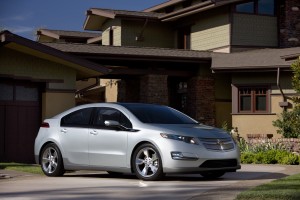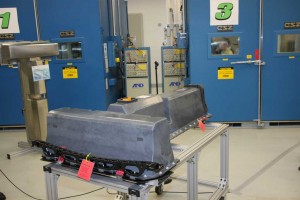General Motors has decided that it will charge a set price for its upcoming Chevrolet Volt plug-in hybrid, rather than allowing customers to buy the vehicle and then lease the battery for a set monthly fee.
That alternative approach is the one Nissan appears to be pursuing for its own high-tech car, the Leaf battery-electric vehicle, or BEV, which will charge into U.S. showrooms shortly after GM puts Volt on sale, in late 2010.
One of the biggest challenges for the auto industry, in the push towards electrification is keeping costs down to a level that consumers will be willing to spend. “Most people aren’t willing to pay a premium just because a vehicle is green,” cautions Chance Parker, J.D. Power and Associates group vice president and general manager.
For his part, Nissan CEO Carlos Ghosn has said Leaf will have to come in at no more than 2% to 3% above the price of a comparable, gasoline-powered vehicle. But there’s an asterisk after that statement. The 4-door Leaf is expected to be sold for somewhere around $25,000, but buyers will also have to sign up for a separate lease on the car’s lithium-ion battery pack. That, notes Ghosn, will likely be priced at around what a motorist averaging 1200 miles a month might expect to spend on gasoline – generally in the range of $150 to $200.
“Fritz challenged us” to work out a similar strategy for Volt, said a ranking General Motors executive, asking not to be identified by name. A second GM source said the automaker has done extensive market research to see what potential Volt buyers think of the idea. Apparently, it turns out, the answer is “not much.”
“They just don’t like it. They want to pay one price up-front,” said the senior GM source.
That will translate into a price tag of somewhere between $7,500 and $8,000 more than with a combination purchase/lease package. While GM won’t reveal final pricing on Volt until closer to its launch, next year, most industry experts predict a figure close to $40,000, at least 50% more than a conventional sedan of its size and features. That will be offset, however, by a $7,500 U.S. government tax credit on advanced propulsion vehicles.
Most industry observers believe there is a core audience of green-minded buyers who will initial opt for vehicles like Leaf and Volt. GM executives acknowledge the steep price tag for the Chevy plug-in – which the automaker prefers to call an “Extended-Range Electric Vehicle,” or EREV – could turn off more conventional buyers.
But the maker will heavily promote data that shows 70% of American consumers will be able to meet their daily driving needs with Volt’s 40-mile battery range. Using special chargers during off-peak hours, Volt will run on as little as a penny of electricity per mile, barely a tenth the price of gasoline. At that rate, an owner could save perhaps $2,000 on annual gasoline expenditures – even more if fuel prices surge, as expected, once the economy recovers.
There is still a slight chance GM might switch directions and go with a battery lease program, cautioned Brent Dewar, general manager of the Chevrolet division, adding that virtually nothing will be locked down until right before Volt goes on sale.
Chevy might, longer-term, also borrow another page from Nissan, which is considering the idea of eventually offering consumers the option of buying — or leasing — longer-range battery packs for its Leaf. That would, of course, depend on significant improvements in lithium chemistry, in the coming years. Ultimately, a Leaf buyer might choose a standard-issue, 100-mile range battery or pay extra for a larger pack delivering, say, 150 or 200 miles range. Perhaps, with Volt, that same approach would boost battery-only range from 40 to 60, 80 or even 100 miles — for an added price, of course.
(Click Here for more on Nissan’s potential plans to offer upgraded batteries.)
Even if Nissan and GM are diverging on how to handle the high cost of lithium batteries – the single most costly part of electric vehicles – they both agree that the success of the clean technology will require they shift from a business-as-usual approach.
Both makers have been signing up partners to assist in their product roll-outs. NRG Energy, the mega-utility owner, based in Princeton, NJ, announced last month that it would join the list of Nissan affiliates. That will eventually involve steps such as providing high-speed chargers for the Leaf, as well as helping market the BEV, which is expected to yield 100 miles per charge.
Manufacturers like GM and Nissan are also hoping to find partners who would be interested in acquiring used battery packs. It’s expected that the LIon technology will still have plenty of life left, notes GM Vice Chairman Bob Lutz, even after a vehicle like Volt is scrapped – or the battery pack can’t meet on-road operating requirements.
One possibility would be to put old batteries out to pasture, plugging them in at energy farms that could help stabilize loads on the nation’s power grid. That could be particularly appealing to producers of renewable energy, helping stabilize output even when the sun goes down or the wind dies down.



Some of your older Michigan readers will remember when Detroit Edison still distributed free light bulbs….They ran a bulb exchange (bring burnt bulb, get new bulb); the logic being that they’d make up the cost in energy usage.
Perhaps DetEdison should consider subsidizing our Volt batteries in order to create new demand for electricity?
Hi, George,
A very interesting concept and one I expect the utility industry may take you up on, though in what form is unclear. Big dollar outlays for the likes of a Nissan Leaf or Chevy Volt seem unlikely, though we could see the power companies offer free or heavily subsidized fast home charging stations, and we’ll almost certainly see the smarter utilities come up with enticing rate structures based on off-peak charging. As Tony Earley, DTE Energy’s CEO, told me a few weeks back, they can just about give power away at some hours and still make money because of the way the system is set up, churning out power day-and-night. Also look for the utilities to set up or at least help support the expansion of much-needed public charging stations.
Paul A. Eisenstein
Publisher, TheDetroitBureau.com